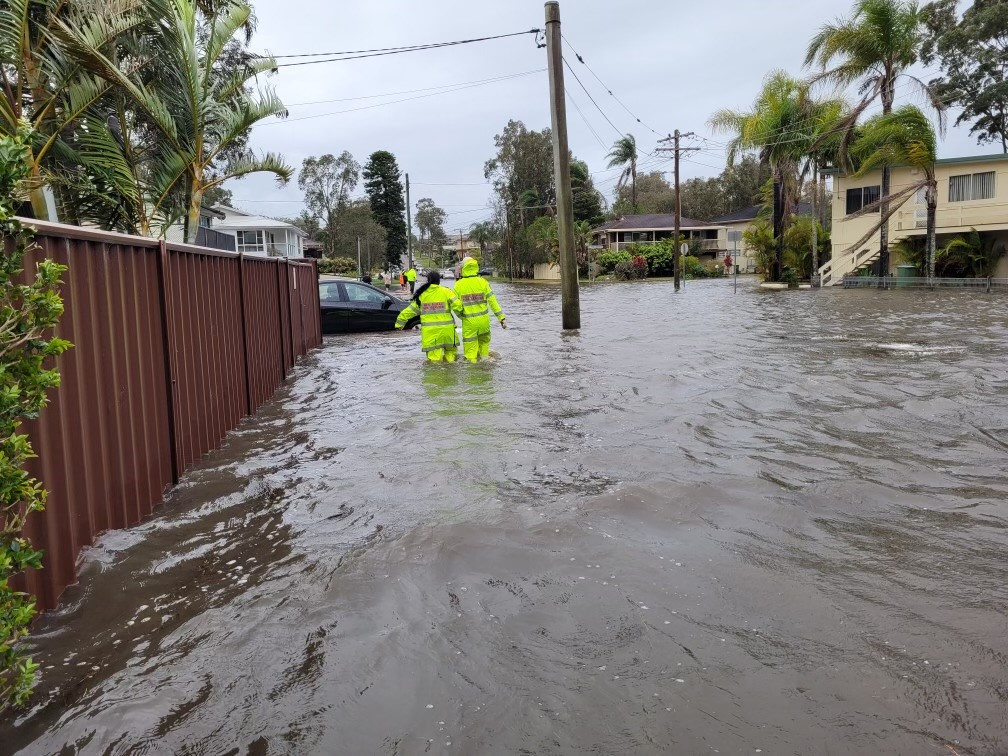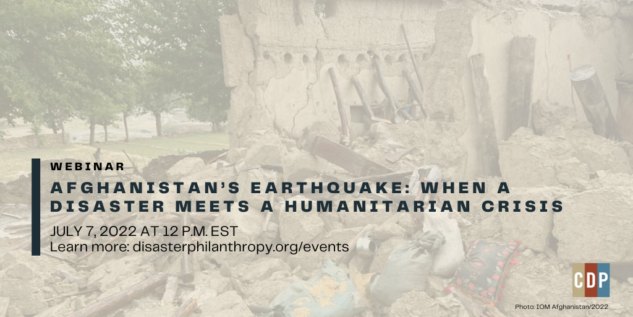What we’re watching: Weekly disaster update, July 5

We know all too well that disaster can strike at any time, in any place in the world. Some disasters make headlines; others do not. Here at the Center for Disaster Philanthropy, we keep an eye on the status of disasters worldwide and compile a list of the ones we’re tracking weekly, along with relevant disaster-related media coverage.
Here’s what we’re watching for the week of July 5, 2022.
New or Emerging Disasters
Flooding – Australia: New South Wales, Australia’s most populous state, is flooding again. Floodwaters inundated hundreds of homes and forced 50,000 people to evacuate. Parts of southern Sydney received nearly 8 inches (more than 20 centimeters) of rain in 24 hours, 17% of the city’s annual average. It continues to be the wettest year on record for Sydney.
This year the La Niña weather system produced more rain, and climate change is expected to increase the frequency and intensity of La Niño and El Niño. Groups warn that the country is underprepared for climate-fueled disasters and are encouraging Australia’s government to spend more on preparedness and mitigation. The latest flooding follows three weather systems along Australia’s east coast from February to April of this year, leading to record rains and flooding.
Earthquake – Iran: A 6.1 magnitude earthquake hit Iran on Saturday, July 2. It was followed by dozens of tremors, including two at 6.3 and 6.1 magnitudes. Five people were killed and nearly 50 injured as the quake destroyed the village of Sayeh Khosh.
Previous/Ongoing Disasters
Earthquake – Afghanistan: On June 22, an earthquake of magnitude 5.9 on the Richter scale hit 29 miles southwest of Khost city. The earthquake struck at a shallow depth of only 6 miles in a region with buildings vulnerable to earthquake shaking.
At least 70% of homes in the high-impact areas have been damaged or destroyed, leaving many people without shelter. The risk of communicable diseases remains high. Women and girls are among the most affected by the earthquake. The multi-sectoral Emergency Earthquake Appeal targets 362,000 people across provinces in southeastern Afghanistan. A total of $110.3 million is needed to provide life-saving assistance. Afghans are helping one another and supporting recovery in their communities.
The country is already facing a humanitarian crisis with a struggling economy, displacement and acute food insecurity.
For more, see the 2022 Afghanistan Earthquake disaster profile. Donors can support long-term recovery efforts through the CDP Global Recovery Fund by choosing “2022 Afghanistan Earthquake.”
We’re hosting a webinar this Thursday, July 7 at 12 p.m. ET to explore the impact of the earthquake and how funders can support immediate & ongoing needs. Learn more and register.
Monkeypox – Global: The Centers for Disease Control and Prevention have confirmed 460 cases in the U.S. As of June 27, the World Health Organization (WHO) said there were 3,413 reported cases from 50 countries since January. Nearly all the cases have been reported since May, and 86% of confirmed cases are from the WHO European Region. Other sources show even higher numbers of global cases. A new study found that monkeypox is mutating surprisingly fast in Europe and North America.
Humanitarian Crisis – Ukraine: Since June 28, there have been more than 8.4 million border crossings from Ukraine since Feb. 24, according to the United Nations High Commissioner for Refugees. As of June 29, United Nations (UN) agencies and partners have reached more than 10.3 million people with life-saving assistance, an increase of 1.5 million compared to the previous week. Internally displaced persons (IDP) in Ukraine face challenges accessing aid and require longer-term housing solutions before winter arrives.
According to Candid, 992 grants worth $1,228,860,746 have been granted so far, with an additional 176 pledges worth $697,238,080. Funders can share their grants data with them by emailing egrants@candid.org.
For more, see the Ukraine Humanitarian Crisis disaster profile and Ukraine Humanitarian Crisis Recovery Fund.
Worldwide – Coronavirus:
Key facts as of July 5:
- Worldwide, cases have surpassed 555 million.
- There have been more than 530 million recoveries and more than 6.3 million deaths.
- The highest number of cases are in the U.S. (89.5 million), followed by India (43.5 million), Brazil (32.5 million) and France (31.4 million).
- Worldwide, 66.7% of the global population has received at least one dose of a COVID-19 vaccine. This number drops to only 20.2% in low-income countries.
Other notable news:
- The World Health Organization (WHO) said new coronavirus cases rose by 18% in the last week globally. WHO Director-General Tedros Adhanom Ghebreyesus said, “This pandemic is changing, but it’s not over.”
For more, see the COVID-19 Coronavirus disaster profile.
U.S. Midwest Low-Attention Disasters
The Midwest is regularly faced with low-attention disasters that affect people across the region. CDP’s Midwest Early Recovery Fund (ERF) effectively funds efforts that catalyze equitable disaster recovery.
These are some of the latest disasters the ERF team is monitoring:
- On June 30, President Biden approved a major declaration for seven Oklahoma counties affected by severe weather in May. Assistance for individuals and businesses and funding for hazard mitigation measures statewide is included.
- Counties that declared a disaster following the derecho in South Dakota in May will be eligible to receive federal funding following President Biden’s approval of a disaster declaration. The declaration includes 20 counties and two reservations, and the funding applies to damage to public buildings and institutions.
Complex Humanitarian Emergencies – Cameroon
Many places worldwide are experiencing emergencies caused by conflict, climate change, drought, famine, economic challenges and other conditions that combine to create a complex humanitarian emergency (CHE). CDP maintains complete profiles on several CHEs.
Violence and insecurity in the Lake Chad basin are linked with Boko Haram’s insurgency in Nigeria’s northeast that crossed over into Cameroon. The North-West and South-West (NWSW) regions are home to separatist groups fighting with the military due to longstanding grievances, resulting in thousands of displaced people. The country is also hosting more than 345,000 refugees from the Central African Republic.
Insecurity in the NWSW regions remains high, with serious implications for local populations. A Human Rights Watch report described the increasing violence and accused rebels in the English-speaking areas of committing human rights violations. Armed groups attacked a village in the Far North between June 12 and 16, burning homes, looting items and forcing the displacement of thousands.
Cameroon is gradually recovering from the socioeconomic impact of the COVID-19 pandemic. However, food prices in the country are well above the five-year average in June 2022. These increases are partly due to the war in Ukraine, which increased commodity and energy prices. A key driver of food needs across the country will be food price inflation.
Humanitarian access remains possible but challenging. Abductions of humanitarian staff, diversion of aid trucks and attacks against educators, have been recently reported. Key priorities include protection, food security, health, water, sanitation and hygiene and shelter.
What We’re Reading
- Louisiana’s insurance market is collapsing, just in time for hurricane season – Grist: “The damage from Hurricane Ida caused at least seven private insurance companies to collapse or cancel their policies, and several more could be on their way out, with dire implications for the state’s housing market.”
- They lost their home in the Marshall fire. Here’s where they stand six months later. – Colorado Public Radio: Despite signs of progress such as cleared lots and debris removal, most families affected by the disaster are not close to bouncing back. The disaster has raised questions about how to rebuild amidst drought and rapid global warming.
- WFP cuts Yemen food rations further due to funding gap, inflation – Reuters: One-quarter of the $2 billion needed for Yemen this year has been funded by international donors. In addition to the funding gaps, global inflation and knock-on effects of the Ukraine conflict have complicated efforts to support millions of people who face hunger.
June 30 marked Asteroid Day, an annual global event that raises awareness of the risks of asteroid impacts. Here’s a quick rundown of five space rocks you should know about.

